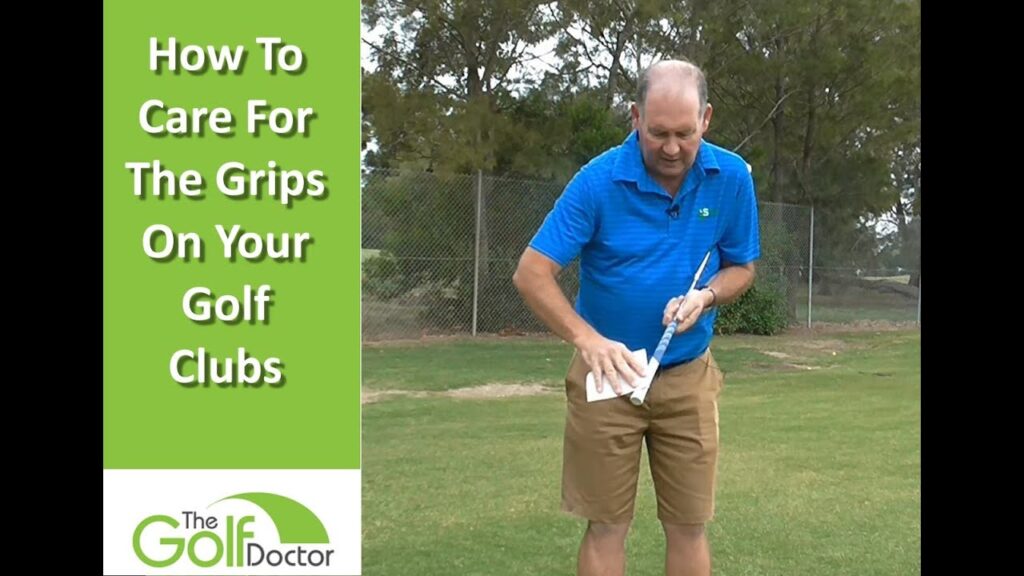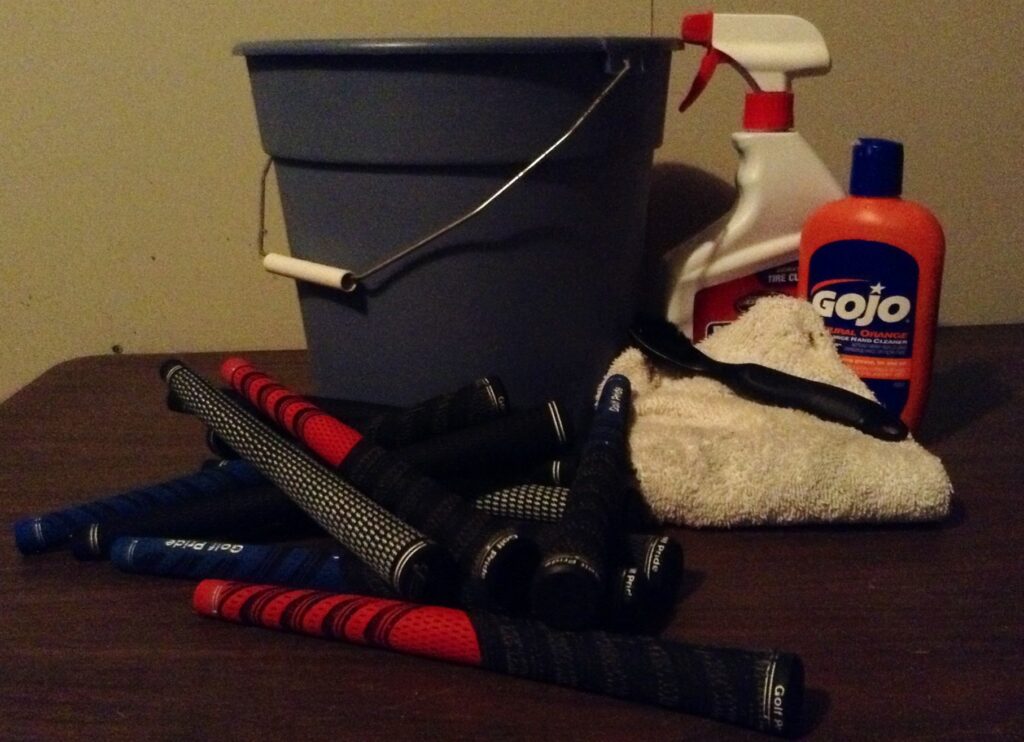Taking care of your golf grips is essential for maintaining a good grip and maximizing your performance on the golf course. In this article, we will guide you through simple and effective ways to care for your golf grips, ensuring their longevity and ensuring your game stays on par. Whether you’re a seasoned golfer or just starting out, these tips will help you keep your grips in top condition, providing you with comfort and control throughout your swings. So, let’s dive in and discover how you can keep your golf grips in tip-top shape.

Cleaning Golf Grips
Regular cleaning
Regular cleaning of your golf grips is essential to maintain their performance and prolong their lifespan. The best way to clean them is by using a mild soap or detergent mixed with warm water. Soak a soft-bristled brush in the soapy water and gently scrub the grips, paying attention to the crevices and textured areas. Rinse them thoroughly with clean water and pat dry with a towel or cloth. This simple cleaning routine should be done after every few rounds of golf to keep your grips in pristine condition.
Deep cleaning
In addition to regular cleaning, it is important to deep clean your golf grips at least once or twice a year. Deep cleaning removes any accumulated dirt, sweat, or oils that may have penetrated the grip’s surface. To deep clean, fill a bucket or sink with warm water and add a few drops of mild soap or detergent. Submerge the grips in the soapy water and gently scrub them with a soft-bristled brush. Rinse them thoroughly with clean water and pat dry with a towel or cloth. Deep cleaning will revitalize your grips and ensure optimal performance on the course.
Removing stubborn stains
Stubborn stains can sometimes mar the appearance of your golf grips. To effectively remove these stains, you can use rubbing alcohol. Moisten a clean cloth or sponge with rubbing alcohol and gently rub the stained areas. This will help dissolve the stain and restore the grip’s original look. However, it is important to avoid using excessive rubbing alcohol, as it may dry out the grips over time. If the stains persist, you can try using a specialized golf grip cleaner, following the manufacturer’s instructions carefully.
Protecting Golf Grips
Using grip covers
One of the easiest ways to protect your golf grips is by using grip covers. These protective covers are designed to fit snugly over your grips, shielding them from dirt, moisture, and excessive wear. Grip covers are particularly useful when storing your clubs or during transportation. They provide an extra layer of protection and help maintain the condition of your grips for longer.
Avoiding excessive moisture
Excessive moisture can deteriorate the performance of your golf grips and shorten their lifespan. It is important to avoid playing in heavy rain or wet conditions whenever possible. If the grips do get wet, pat them dry with a towel or cloth as soon as you can. Additionally, avoid storing your golf clubs in a damp environment, as this promotes the growth of mold and mildew, which can damage the grips.
Avoiding extreme temperatures
Extreme temperatures can have a negative impact on the quality of your golf grips. It is advisable to avoid exposing them to extremely high heat or cold for prolonged periods. High temperatures can cause the grips to become sticky and lose their tackiness, while low temperatures can make them stiff and less responsive. Whenever possible, store your golf clubs in a temperature-controlled environment to protect the grips and ensure their longevity.
Maintaining Golf Grips
Replacing worn grips
No matter how well you care for your golf grips, there will come a time when they need to be replaced. Worn grips can significantly affect your swing and grip stability, resulting in an inconsistent performance on the course. As a general guideline, if you notice any visible cracks, tears, or extreme smoothness on the surface of your grips, it is time to consider replacing them. Consult with a golf professional or visit a reputable golf store to select the appropriate grip size and material for your game.
Rotating grips
Rotating your golf grips is another maintenance technique that can extend their lifespan. By rotating, we mean interchanging the positions of your clubs’ grips to ensure even wear. This is particularly important for your most frequently used clubs, such as the driver, iron, or putter. By rotating the grips, you distribute the wear and tear more evenly, allowing them to last longer before needing replacement.
Checking for signs of wear
Regularly checking your golf grips for signs of wear is essential to catch any issues early on. Run your fingers along the grips and inspect them closely for any visible cracks, tears, or shiny areas. Smooth or worn spots indicate that the grip has lost its traction, which can affect your ability to hold the club securely during your swing. By regularly monitoring the condition of your grips, you can take prompt action when necessary and avoid any performance setbacks on the course.
Storing Golf Grips
Proper storage position
The way you store your golf clubs can greatly impact the condition and longevity of your grips. It is best to store them in an upright position, with the clubheads facing upwards and the grips facing downwards. This helps prevent any unnecessary stress or deformation on the grips. Additionally, avoid resting your clubs on hard surfaces or leaning them against walls, as this can cause the grips to become misshapen or damaged over time.
Using grip tape
Grip tape is a helpful tool for storing your golf clubs. It is a self-adhesive tape that you can wrap around the grips when not in use. Grip tape provides an extra layer of protection, shielding the grips from dust, dirt, and other potential contaminants. Before wrapping the grips with grip tape, make sure they are clean and dry to avoid trapping any moisture. When you’re ready to use the clubs again, simply remove the grip tape and your grips will be clean and ready for action.
Avoiding exposure to chemicals
While it is important to clean your golf grips, it is equally important to avoid exposing them to harsh chemicals. Chemicals such as solvents or petroleum-based products can damage the material and negatively affect the grip’s performance. When cleaning your clubs or any other equipment, make sure to use mild soap or detergent, as mentioned earlier. Also, be cautious when using certain golf course chemicals or cleaning agents, as they may come into contact with your grips. When in doubt, always refer to the manufacturer’s guidelines for cleaning and maintenance.

Preventing Grip Slippage
Using grip enhancers
Grip enhancers can be a game-changer when it comes to preventing grip slippage. These products, such as grip sprays, powders, or lotions, provide an extra layer of tackiness or grip to the surface of your grips. They help reduce the chances of your hands slipping during your swing, ensuring a secure and confident grip. Depending on the type of enhancer you use, follow the instructions provided by the manufacturer to apply it to your grips properly.
Powdered grips
Powdered grips are a popular choice among golfers seeking extra grip security. These grips have a special coating that creates a slightly tacky surface, providing better traction and preventing slippage. If you prefer this type of grip, make sure to keep the grips clean by regularly wiping them with a clean towel or cloth. The powder coating can wear off over time, so a proper cleaning routine is crucial to maintain their effectiveness.
Proper grip pressure
One of the simplest ways to prevent grip slippage is by applying proper grip pressure. Gripping the club too tightly can restrict your natural swing motion and cause tension in your hands and forearms. On the other hand, gripping the club too loosely can lead to a loss of control and potential slippage. It is important to find the right balance and maintain a consistent grip pressure throughout your swing. Practice different grip pressures during your practice sessions to find the optimal pressure that works for you.
Cleaning Materials and Tools
Mild soap or detergent
When it comes to cleaning golf grips, choosing the right cleaning agent is crucial. A mild soap or detergent is the ideal choice, as it effectively removes dirt and grime without damaging the grip material. Avoid using any harsh chemicals or abrasive cleaners, as they can deteriorate the grips over time. Make sure to rinse off the soap or detergent completely after cleaning and pat the grips dry with a towel or cloth.
Soft-bristled brush
A soft-bristled brush is an indispensable tool for cleaning golf grips. Its gentle bristles can effectively remove dirt, sweat, and other residues from the textured surface of the grips. When using a brush, be careful not to scrub too vigorously, as excessive force may damage the grip material. Gently brush the grips in circular motions, paying particular attention to the crevices and recessed areas.
Rubbing alcohol
Rubbing alcohol is a handy tool when it comes to removing stubborn stains from your golf grips. It acts as a solvent and helps dissolve the stain, restoring the grip’s original appearance. Moisten a cloth or sponge with rubbing alcohol and gently rub the stained areas. It is important not to use excessive rubbing alcohol, as prolonged exposure may dry out the grips. Always use rubbing alcohol in moderation and follow up with a thorough rinse and dry.

Protective Products for Grips
Grip covers
Grip covers are an excellent investment to protect your golf grips. These covers are typically made of soft and durable materials, designed to fit snugly over your grips. They shield the grips from dirt, moisture, and excessive wear, particularly during transportation or storage. Grip covers are easy to use and provide an extra layer of protection, ensuring that your grips stay in optimal condition for longer.
Rain gloves
Rain gloves are another useful protective product for your golf grips. Made with waterproof materials, they provide a secure grip even in wet conditions. Rain gloves have a textured surface that enhances traction and prevents slippage, giving you the confidence to swing with ease. These gloves are particularly useful during rainy or humid days on the course, preventing moisture from affecting your grip and overall performance.
Towel or cloth
A simple towel or cloth is a versatile tool when it comes to protecting your golf grips. Having one handy allows you to quickly wipe off any moisture, dirt, or sweat that may accumulate on the grips during your round. Regularly drying your grips with a towel or cloth helps maintain their cleanliness and prevents them from becoming slick. Remember to choose a towel or cloth that is clean and lint-free to avoid transferring any debris onto the grips.
Maintenance Tools for Grips
Golf grip tape
Golf grip tape is an essential tool for maintaining and replacing golf grips. It is a double-sided adhesive tape specifically designed for securing grips to club shafts. When replacing worn grips, grip tape ensures a secure and durable bond between the grip and the shaft. It is important to use high-quality grip tape and follow the manufacturer’s instructions carefully for proper installation.
Utility knife
A utility knife is commonly used in golf grip maintenance for removing old grips or tape. When replacing worn grips, the utility knife allows you to carefully cut and remove the old grip without damaging the shaft. It is crucial to exercise caution when using a utility knife to avoid any injuries. Take your time and use steady, controlled motions to safely remove the old grip or tape.
Rubber golf grip vise clamp
A rubber golf grip vise clamp is a specialized tool for securing golf clubs during grip installation or maintenance. It consists of a clamp with rubber jaws that hold the club shaft firmly without causing any damage. The vise clamp securely holds the club in place while allowing you to work on the grip comfortably. It is a valuable tool for those who prefer to replace their grips at home.

Replacement Considerations
Grip size and material
When it comes to replacing your golf grips, there are several considerations to keep in mind. Firstly, the grip size should be chosen according to your hand size and personal preference. Grips come in various sizes, ranging from undersized to oversized, to accommodate different hand sizes. Secondly, the grip material plays a role in your overall feel and performance. Common grip materials include rubber, synthetic compounds, and corded grips, each offering different levels of tackiness and durability. Experimenting with different grip sizes and materials can help you find the perfect match for your game.
Professional installation
While some golfers may choose to replace their grips themselves, others prefer professional installation. Professional club fitters and golf stores have the expertise and equipment to ensure proper grip installation. They can assist in choosing the right grip size, material, and style, and provide precise installation techniques. Professional installation ensures that your grips are securely attached and ready for optimal performance on the course.
DIY grip replacement
For those who prefer a do-it-yourself approach, grip replacement can be a rewarding and cost-effective option. With the right tools and guidance, you can successfully replace your golf grips at home. However, it is important to thoroughly educate yourself on the proper grip replacement techniques to avoid any mishaps or damage to your clubs. There are numerous online tutorials and instructional videos available that can guide you through the process step by step.
Warning Signs of Worn Grips
Visible cracks or tears
Visible cracks or tears in the surface of your golf grips are clear indicators that they are worn and need replacement. Over time, the constant use and exposure to various elements can cause the grip material to deteriorate, leading to cracks or tears. These imperfections not only compromise the grip’s performance but can also cause discomfort or blisters during your swing.
Smooth or shiny surface
Another warning sign of worn golf grips is a smooth or shiny surface. As you grip the club and swing, the constant friction between your hands and the grip can gradually wear away the material. This wear results in a smooth or shiny appearance, indicating that the grip has lost its original texture and traction. Without proper grip, your hands may slip during the swing, affecting your control and overall performance on the course.
Lessened traction
The primary purpose of golf grips is to provide traction for a secure grip on the club. Over time, the grip’s material can wear down or become contaminated with dirt, sweat, or oils, reducing its ability to provide adequate traction. If you notice that your hands are slipping or sliding on the grips, it is a clear sign that they have worn down and should be replaced. Maintaining proper traction is crucial for a consistent swing and optimal control.
In conclusion, caring for your golf grips is imperative for maintaining their performance and longevity. Regular cleaning and deep cleaning, as well as removing stubborn stains, are essential to keep them in optimal condition. Additionally, protecting your grips from excessive moisture, extreme temperatures, and exposure to chemicals is crucial. Regularly maintaining and checking your grips for wear will allow you to detect any signs of damage early on. Properly storing your grips, cleaning materials, and using protective products and maintenance tools are all important aspects of grip care. Moreover, preventing grip slippage with enhancers, powdered grips, and proper grip pressure will enhance your performance on the course. Finally, understanding the warning signs of worn grips and considering replacement options ensures that you always have a secure and comfortable grip. By following these guidelines and incorporating them into your golf grip care routine, you can enjoy consistent performance and prolong the lifespan of your grips.







